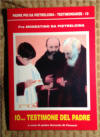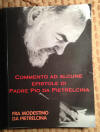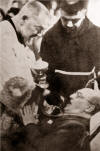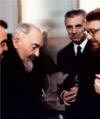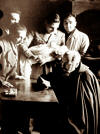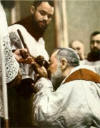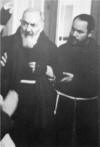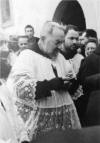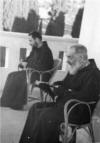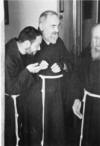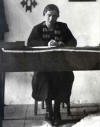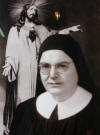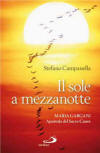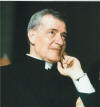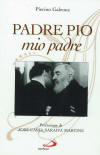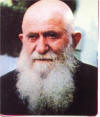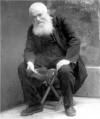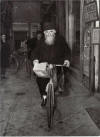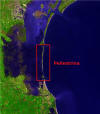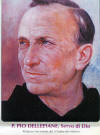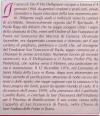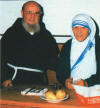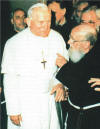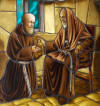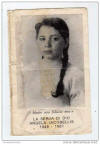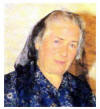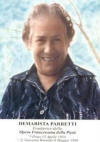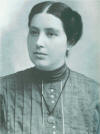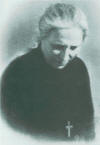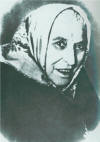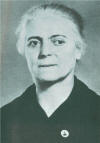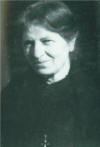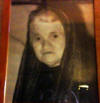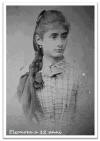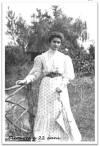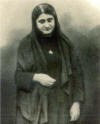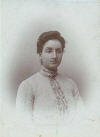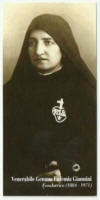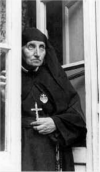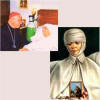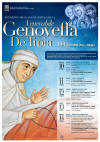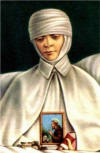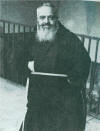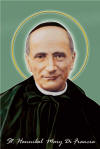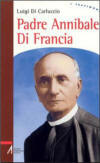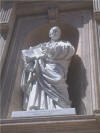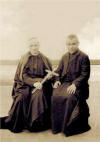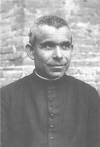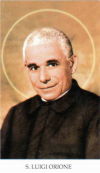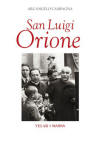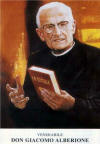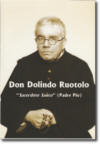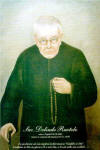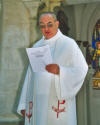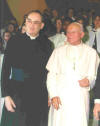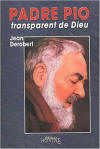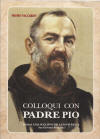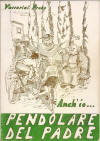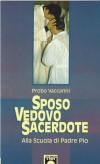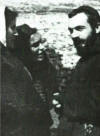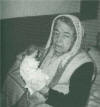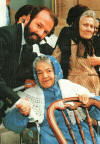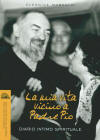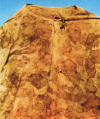10 Spiritual children, Prayer Groups
Summary: group meetings, recruiter, Padre Pio, how they became, some:
Daniele Natale, Maria Gargani, don Pierino Galeone, Fra’ Modestino,
Cleonice Morcaldi (plays)(bloody laundry). Prayer Groups.
Group meetings
The great number of spiritual children of Padre Pio are scattered all
over the world.[1]
San Giovanni Rotondo in 1916, when the group started.
It took a long hard walk on foot to reach the convent.
The first spiritual daughters were Rachelina Russo, her niece Rosinella
Gisolfi. Lucietta Fiorentino, her sister Giovanna and Paolina, her
sister in law Filomena Fini. Vittorina Ventrella, with her sisters
Elena, Maria, and Filomena, their aunt Paolina, and their friend
Maddalena Cascavilla. Maria Anna Campanile, known as Nina, her friend
Girolama Longo. Maria Pompilio and her sisters; Maria Massa, Mariuccia
Riccardi, Angelina Serritelli, Assunta di Tomaso. Esterina Merla,
Rosinella Pagliara; Annina Della Croce, Emanuela Tricario.[2]
The group started meeting in 1916, in the afternoon, on Thursdays and
Sundays, mostly in the guestroom of the friary, and at times in one of
the member’s house.[3]
Nina Campanile: “Padre Pio gave us talks about spiritual formation,
usually taken from evangelical parables.”
[4]
Vittorina Ventrella: “From the parables as a starting point Padre Pio
would teach us of the detachment from earthly things and the
mortification of the senses.”[5]
Nina Campanile: “Sometimes the meetings took place at one of our houses
when Padre Pio couldn’t come. Often Rosinella Gisolfi saw that Padre Pio
was present during our meetings and used to warn us: “Padre Pio is here
with us.”[6]
The meetings began to slow down and were suspended completely during the
epidemic of the Spanish flu.”[7]
Later Padre Pio continued the spiritual formation through letter,
individual meetings, and in the confessional.[8]
Vittorina Ventrella: “We would have liked him to spend the same amount
of time for each of us, and we grumbled and felt upset when he stayed
with someone longer.”[9]
They also complained that Padre Pio “Treated some more gently and others
more harshly.”[10]
Padre Pio to Filomena Fini: “You must realize that I don’t act by
chance, but by God’s will. To some souls it is necessary to give milk,
and to others solid food.”[11]
Nina Campanile: “For some spiritual daughters who had the quality to
teach others Padre Pio had special regard and called them teachers,
because they could pass on his teaching.”[12]
The first tasks were to prepare children for the First Communion,
distribute money to the needy, help with the correspondence.[13]
On time the number of spiritual children grew greatly.
One day Cleonice Morcaldi asked:
“”How big is you flock?” Padre Pio: “It’s immense.”[14]
Padre Pio recruiter
Padre Pio to Count John Telfner in 1936: “Why don’t you stay here?” He
did leaving behind a life of privilege.
To Rina Giostrelli, the wife of Count John Telfner, Padre Pio said:
“Before you were born, God entrusted you to me.”[15]
“Do you wish to stay here in San Giovanni Rotondo?” She replied: “Yes
Padre Pio.” She was twenty years old.[16]
To Mary Pyle: “Don’t travel anymore. Stay here.”[17]
To Dr. Mario Sanvico: “I want you here, I need you”.[18]
To Dr. Carl Kisvarday:
“I want you close to me, very close to me.”[19]
To dr. Guglielmo Sanguinetti: “You have to come here to help me to build
a large hospital. Sell what you have and come to live here.
You have a piece of paper that will soon solve your problems.”[20]
To Angelo Battisti: “Angelino, keep working. I will take care of the
rest.”
Angelino was an administrator in the Vatican. Padre Pio offered him to
administer Casa Sollievo. He did it for eleven years.
Engineer Nora Figna was facing many difficulties, including the fact
that her family didn’t want for her to move to San Giovanni Rotondo.
Padre Pio: “For them to take you, I have to send you. And I will never
send you back. You instead must always stay here.”[21]
Anna Cancellario built the hotel “Villa Pia” for the pilgrims. She asked
Padre Pio why she had had the call when she was already thirty five.
Padre Pio: “I already knew you when you were four; and when you were
fifteen. I have always known you.”[22]
Elisa Salvucci met Padre Pio on May 11, 1956. Padre Pio said: “Stay
here.” She did.[23]
Piero Melillo settled in San Giovanni Rotondo after a long struggle.
Padre Pio: “I showed you many paths to come to me, but it was useless:
only your father’s illness made you move.”[24]
Pina Patti went to San Giovanni
Rotondo as a substitute teacher in secondary school. Padre Pio: “If you
stay here, you will be happy here.”[25]
Padre Pio father
"I belong entirely to everyone. Everyone can say: Padre Pio is mine."[26]
“I belong entirely to everyone. Because of it I suffer immensely for
everyone.”
[27]
“I am all for everyone, and there is still a little bit left over.”[28]
"I have made a pact with the Lord: I will take my place at the gate to
Paradise, but I shall not enter until I have seen the last of my
spiritual children enter."[29]
[30]
[31]
“I can forget myself, but not my children; I tell you that when the Lord
will call me, I will stay at the door of paradise and I will tell Him:
‘Lord, I do not enter before I see that all my children have entered.”
Cleonice Morcaldi asked Padre Pio: “Did
you really say that? “ Padre Pio: “I made this proposal to the Lord.
I don’t know if He accepts it.”[32]
“When a soul approaches me, I take it. When I have taken a soul, I never
let it go.”[34]
“If a soul slips from me and goes away, I pray and suffer for her
return, and when she has returned I retake her, and don’t let her run
away again.”[35]
"If one of my spiritual children ever goes astray I shall leave my flock and seek him out."[36]
“It is true I make my penitents sweat blood. But I also add my own
blood.”[37]
"I love my spiritual children as much as my own soul and even more."[38]
“I can hit my children. I want to bring them up fast with blows, but woe
that lay a hand on them.”[39]
“How come at times you are a bit harsh?” Padre Pio: “To destroy the old
and insert the new.”[40]
“I work to give my children the heritage.”[41]
“When I have lifted a soul, I don’t let it fall down again.”[42]
"When the Lord entrusts a soul to me, I place it on my shoulder and
never let it go."[43]
“After I die I will be closer to you than I am now. I will watch over
you better, because I won’t be suffering there.”[44]
"When I am in heaven I will be able to do more".[45]
To Padre Marcellino:”I will be able to do more from there than I can
here.”[46]
How they become spiritual children
Many today still ask: “How did one become a spiritual child of Padre Pio?”[47]
Lucietta Pennelli from San Giovanni Rotondo had received the first
Communion from Padre Pio, and confessed with him every week. When she
was a teen ager asked Padre Pio if he would take her as a spiritual
daughter. Padre Pio: “And of whom have you been a daughter up to now?”[48]
Rino Gerolometti had been confessing with Padre Pio for several years.
In the summer of 1968, at the end of confession, Padre Pio said: “Go
now, my son!” Rino was deeply moved that he had be called son, and
concluded that he was now his spiritual child.[49]
Sister Carmelita Mannella asked to become his spiritual daughter. Padre
Pio: “Yes. Be a fervent Christian, a fervent nun.”[50]
To Alma De Concini: “Yes, but look here, you must be good.”[51]
To Ennio Staccioli: “Very well, but be careful not to make me leave
you.”[52]
To sister Eleanora Di Carlo: “But do you know what it means for me to
answer yes? That you get me into trouble.”[53]
To Maria Fusco: “I can give you a push, but you have to work hard to go
ahead.”[54]
To Padre Dino, marianist: “Very well! But remember that if you don’t
behave yourself, my slaps will reach you, wherever you are.”[55]
To Padre Antonio Di Leva: “Yes, because I am a fool.”
To Enzo Picciafuoco: “Yes, but be sensible! If not there will be blows.”[56]
To Pietro Cugino: “Be a good Christian. Observe God’s law. The Lord does
not ask much. If you will do so, God will be happy, and so will I.”[57]
Sauro Volpe from Viareggio had a dream where Padre Pio told him: “Come
visit me.” After months he visited Padre Pio. After confession he said:
“May I consider myself your spiritual son? “ Padre Pio: “Certainly!
Otherwise why would I have called you!”[58]
Padre Pio meeting spiritual daughters
Padre Pio meeting Mary Pyle
How to become spiritual children
In 1956 Fra’ Modestino got the promise from Padre Pio that if we say a
five decades rosary every day, and now and then have a Mass celebrated
for Padre Pio’s intention, we will become Padre Pio’s spiritual
children.[63]
On September 20, 1968, three days before his death, Padre Pio gave to
Modestino his own rosary and said: “Here, I entrust to you the holy
rosary. Diffuse it among my children.”[64]
Every night, at 21:00 PM, at the tomb of Padre Pio there is always a
large gathering of people praying the rosary.[65]
Fra’ Modestino’s statement: “All that, from their homes, join the
praying of the rosary from 9 to 9:30 PM, at the tomb of Padre Pio, and
now and then have a Mass celebrated for Padre Pio’s intention, become
Padre Pio’s spiritual children. I assure you of this, under my own
responsibility.”[66]
People pray the rosary at the tomb of Padre Pio every night at 9:00 P.M. (Italy time)
It can be seen live at the web site below:
http://www.teleradiopadrepio.it/
Some spiritual children
Giacomo Gaglione
Giacomo Gaglione lived paralyzed for more than fifty years. Padre Pio
said of him when he died on May 28, 1962: “He has been with Jesus on the
Cross, and now he is with Jesus in Paradise”.
Enrico Medi
Enrico Medi, scientist physicist, currently Servant of God
Enrico Medi: “Padre Pio for 27 years has guided my life with infinite
wisdom.”
Nicola Cocomozzi
Nicola
Cocomozzi, employee of the post office in San Giovanni Rotondo, brought
for several years to Padre Pio
the mail items that needed his signature. Padre Pio blessed Nicola's
wedding, and also baptized his child.
Giovanni Bardazzi
Giovanni Bardazzi from Prato, near Florence in Tuscany met Padre Pio in
1950. In confession he was denied the absolution for three times over
several months. The forth time Padre Pio gave the absolution, and
Giovanni was transformed in a God loving person. He started a business
driving people from the Prato area to San Giovanni Rotondo several times
a year, first in a Lancia Aurelia B15-2000 with nine passenger
seats.then with a bus when the number of pilgrims grew. He started
numerous charities and built the church of Saint Mary of Graces in
Calenzano, as directed by Padre Pio: “My son, you will build a church
and a house for you.” “Your house will always be open for those in
need.”
Fra Daniele Natale
Michele Natale was born in
San Giovanni Rotondo in 1919.
In 1935 he went to Morcone for the novitiate, and joined the Capuchin
family with the name of Frà Daniele. He renounced the studies for
priesthood, and decided to be a lay brother. He did cooking, alms
seeking, door keeping, and sacristan.
Padre Pio offered to become his spiritual father, and gave him the
incumbency of animator of the prayer groups.Fra Daniele was very pious,
and many people got helped by his words and prayers.
He died at 75 in 1995, and rests in the cemetery of San Giovanni Rotondo.
On March 8, 2012, the Archbishop Michele Castoro, opened the diocesan
process of canonization, and Fra Daniele was named Servant of God.
Maria Gargani
Maria Gargani was born in Morra Irpina, the last of eight children. She
was an elementary school teacher, very, religious, with an intense
spirituality.
Padre Pio never started spiritual direction by letter without permission
from his superiors. In this case both Padre Benedetto and Padre Agostino
encouraged and approved. Padre Pio wrote 67 letters to Maria. The first
one was on August 26, 1916. In that letter Padre revealed that Jesus had
let him know her soul.[59]
In 1923 by disposition of the Holy Office Padre Pio stopped writing
letters. The last dated
letter from Padre Pio to Maria Gargani was written on May 16, 1923. In
the letter Padre Pio confides: “These days I feel like I am in and
infernal prison.”[60]
In his direction of Maria, Padre Pio was firm and unwavering. Maria
Gargani, besides teaching, was active member of Catholic Action, and of
Thir Order of St. Francis. On April 21, 1936 she founded the Apostles of
the Sacred Heart, with Padre Pio’s approval. Maria died on May 23, 1973.
Currently she has the title of Servant of God. Her process of
canonization is ongoing.
Don Pierino Galeone
Don Pierino met Padre in 1947. In 1945 he had been diagnosed with
tuberculosis while he was seminarian in Molfetta. He left the seminary
and went for treatment for two years. He spent several days in San
Giovanni Rotondo without telling Padre Pio about his medical condition.
The day he was leaving, Padre Pio put his hand on don Pierino’s chest,
passing all over it. Then he said: “You can die of anything else but not
of this.”
Don Pierino had many supernatural experiences in hic contact with Padre
Pio. He is the founder of the secular institute “Children of Suffering.”
He was an important witness in 1986, in the process of beatification,
and concelebrated with the pope at the ceremonies of Beatification and
Canonization.
Don Pierino lives in Puglia, not far from San Giovanni Rotondo.
Mons. Galeone wrote the book: Pierino Galeone, Padre Pio mio padre,
Edizioni San Paolo, second Edition 2009.
Rev. Olinto Marella known as “Padre Marella”
Padre Marella
Pellestrina
Born in 1882 in Pellestrina, an island on the Lagoon of Venice.
Studied at the Apollinare College in Rome, earning a doctorate in
Theology. The future Pope John XXIII was his classmate.
Ordained in 1904, was suspended ‘a divinis’ in 1909. In 1919 got a PhD
in History and Philosophy. In 1925 he was reinstated in the clergy.
Don Olinto dedicated his life to the poor and neglected, especially
children, begging at street corners. He founded in Bologna a “Boy’s
Town” and in Bologna and Ravenna an institution for the families in need
currently called “Opera Padre Marella”.
Padre Marella visited Padre Pio in San Giovanni Rotondo and was
encouraged in his dedication to the poor.
The diocesan process for his beatification was completed in 2005. Padre
Marella is currently Servant of God.
Padre Pio delle Piane
Born in 1904 in Genova-Marassi. In 1924 become a friar of the Order of
Minims.
Padre Pio visite frequently with Padre Pio.
Padre Andrea D’Ascanio recalled that when Padre Pio da Pietrelcina was
asked about Padre Pio delle Piane he said: “Padre Pio of the plains? No.
Padre Pio of the peaks!”
Now servant of God. The diocesan process was completed in 1998.
Elena Bandini
Elena Bandini (center, and far right)
Born in 1893 in Borgo San Lorenzo (Florence).
She was member since young age of the Franciscan Third Order, helping
the apostolate of Padre Massimo da Porretta.
Elena met Padre Pio in 1921. She received 24 letters from him, and also
exchanged more than one hundred of questions and answers on small pieces
of paper. In 1936 she moved to San Giovanni Rotondo.
Elena Bandini had been helping for many years the church, the monastery, and the local people of San Giovanni Rotondo. She played the organ and directed the choir in the church of St. Mary of the Graces. She suffered from stomac cancer, which eventually took her to death. "She asked for no cure. She wanted to unite her sufferings to those of Padre Pio and offer them for his intentions." When she died, John McCaffery told Padre Pio: “She certainly went without any stop from here to Paradise”. Padre Pio with two great tears rolling down his cheeks: “Oh! Without stop at all!”
Fra’ Modestino
Damiano Fucci was born in 1917 in Pietrelcina, the birthplace of Padre
Pio. His parents were childhood friends of PadrePio.
Padre Pio told him: “My son, I will constantly be near you, and the
sight of Saint Francis will always be on you.”[62]
Angela Iacobelli
Born in Rome 10-16-48. Before receiving Fist Communion she used to hug
and kiss her parents returning from Mass and communion, because for her
it was ‘like hugging Jesus’. She wrote: “The love of Jesus is wonderful.
Everything changes, everything transforms, but He is always the same.”
When she heard cursing she wound grab the arm of whomever was nearby and
say: “Let’s make reparation right away, lest’s say a Salve Regina.”
At 11 Angela contracted leukemia.
On September 19, 1960 she went with her parents to Padre Pio. She
confessed with him.
“Padre, You have to rip this grace from the Madonna. I say the Rosary
every day. I can’t stand seeing my mother suffering so much. If the
Madonna gives me the vocation, I’m willing to become nun.” Padre Pio:
“Brava! Brava!”
“I have been sending to you my guardian angel every day. Did he come? Do
you listen to him?” Padre Pio: “Of course I listen to him!”
Padre Pio told her not to be discouraged, to pray and confide in the
Lord, and that she needed to do God’s will.
Angela wrote to Padre Pio every ten days. She became his spiritual
daughter.
Angela suffered atrociously until the last day of her life.
Angela died on March 27, 1961. She was 12 years old.
Her body stayed uncorrupted and rests in the church of San Giovanni dei
Fiorentini in the Vomero section of Napoli (Italy).
On June 11, 1991, the Holy Seen gave the “Nihil Obstat” for the
introduction of the cause of beatification. In 1999 a prodigy has been
attributed to Angela.
Angela Jacobelli in now venerated as Servant of God.
Demarista Parretti
Demarista Parretti
The day of the First Communion she saw her guardian angel.
Since she was eleven, a little statue of the Virgin Mary reminded her to
say her prayers in the evening.
At 12 she fell from a moving cart. For years didn’t tell anybody of the
severe pains in her low back. The ‘sacrum’ bone had to be removed.
At 16 St. Francis told her: “One day you will follow me.”
On May 15, 1946 she met Padre Pio and became his spiritual daughter. She
returned numerous times.
In 1961, under his guidance she started the “Casa Francescana della
Pieta’” for elderly people in Virginiolo Montespertoli, in Campi
Bisenzio.
Annita Rodote
Born in Foggia in 1890, she
learned from a certain Francesca to be a seamstress, and worked in the
Cerase family. Orphan at young age, after two negative cloistral
experiences, became nun with the Sisters of the Holy Spirit in Ariano
Irpino.
Padre Pio wrote her at least 21 letters from 1914 to 1923.
He wrote on how to meditate (Epistolario 3, 63), and how to behave in
and out of church (Epistolario 3, 86-9).
The nest of the halcyons (3, 109-10; 3, 274 Maria Gargani).
“When you can’t take big steps on the road to God, be happy taking small
steps, patiently waiting to have legs able to run, and even better wings
to fly.” (Epistolario
3, 115) (Epistolario 3, 432)
(Epistolario 3, 859) (Epistolario 3, 959)
Margherita Tresca
Margherita Tresca
Born in Barletta in 1888. Padre Pio and Margherita never met in person
(3, 155). Padre Benedetto told Padre Pio about her in 1913. The
correspondence between Padre Pio and Margherita includes 27 letters
between 1915 and 1021.
Because her parents rejected the idea that she became a nun, in 1919
Margherita run away from home to enter the congregation of the
Bridgidines in Rome.
“A passenger, locked in a windowless cabin of the ship, doesn’t see the
ship and doesn’t perceive the she is moving. If the passenger is
concerned about the rolling of the ship, he fears that the rolling means
that the ship will sink soon to the bottom of the sea. If he gets on the
deck he will see that the ship is floating and is sailing at high speed,
and it only shakes because of its own strength in breaking the waves. ”
(Epistolario 3, 191) (3, 973)
“Don’t look for God away from you: God is in you.” (Epistolario 3, 199)
Assunta Di Tomaso
Born in Casacalenda in 1894. She was the sister of Padre Paolino da
Casacalenda, superior of the convent from 1914 to 1919.
She embroidered linen for the altars of the church. Padre Pio: “I have
seen the linen that you have done for the church. I like them very much.
May Jesus give you an adequate compensation.” (Epistolario 3,
416)
Moved to San Giovanni Rotondo after the death of her parents.
While sick in bed she was visited by Padre Pio on March 16, 1947.
Padre Pio told Padre Paolino that she would not die now. She died on May
17, 1953.
Before expiring she sat on the bed and said: “Oh! I’m already in
Paradise.” (Epistolario 3, 394).
Assunta received 27 letters from Padre Pio between 1916 and 1923.
“The blind belief and the total adhesion to the authority established by
God is the lamp that lightens the steps of the people of God. It is like
the light that guided the Magi to adore the born Messiah.” (Epistolario
3, 400)
“The more winter is harsh spring will be more beautiful, richer in
flowers, and with a more abundant harvest.” (Epistolario 3, 431)
(Epistolario 3, 1067)
“Be happy to be a little bee now still living in the nest. Soon you will
become a big bee, able to produce honey.” (Epistolario 3, 432)
(Epistolario 3, 859) (Epistolario 3, 980)
Rachelina Russo
Born in 1875 in San Giovanni Rotondo, she helped the convent since the
friars returned in it in 1909.
In 1919 she met Padre Pio, who was still in Foggia. She received 16
letters from Padre Pio, all of them dating before he moved to the
convent in San Giovanni Rotondo.
Rachelina Russo became spiritual child of Padre Pio with her nieces
Rachelina Gisolfi, and Rosalia (nicknamed Rosinella) Gisolfi.
Rachelina died on February 7, 1968.
Vittorina (Maria Vittoria) Ventrella
Born in 1882 in San Giovanni Rotondo. Whit her sisters Elena Maria, and
Filomena, they met Padre Pio in the first few days he moved to San
Giovanni Rotondo in 1916, and become his spiritual daughters.
The Ventrella sisters received 43 letters from Padre Pio between 1916
and 1922.
“The gardener has different care for different plants.”( Epistolario 3,
593)
Antonietta Vona
Born in Castrocielo in 1886.
In 1917 Antonietta went on vacation to Casamicciola, where she met
Giuseppina Morgera.
The Morgeras sent to Padre Pio a plate of “rape”, his favorite food
every day. Antonietta and Giuseppina went to visit Padre Pio, military
in Naples.
In 1919 she visited Padre Pio in San Giovanni Rotondo, after the news of
the stigmata had spread.
After WWII she moved to San Giovanni Rotondo.
She spent the last two years of life in bed with severe arthritic pains.
Padre Pio visided her and said: “Antonietta, lets suffer for our
brothers.” She died on November 19, 1949.
On the souvenir card Padre Pio wrote: “She was one of the few souls that
God was pleased with. She lived in profound humility and suffered
continuously; all consumed in God and for God, where she now eternally
rests.” (Epistolario 3, 813-6).
“Those who have felt the pricking of the crown of thorns of the Savior
don’t feel any other wound.” (Epistolario 3, 827)
“I don’t know if I am directing well the souls that the Lord sends me.
They keep increasing in number. I don’t know if I have sufficient
spiritual light to guide them. I am tentative, confiding in the pale and
cold doctrine I have learned from the books, and on the little light
that comes to me from the High above.” (Epistolario 3, 851) (Epistolario
3, 951)
“In Heavens everything will be spring as far as beauty is concerned.
Will be fall as far as pleasure, and will be summer as far as love.”
(Epistolario 3, 855)
Maria Anna (Mariannina) called Nina Campanile
Padre Pio had just moved to San Giovanni Rotondo in 1916, when she was
suggested to meet the “holy friar”. She refused.
Few weeks later the campanile family was notified that Nina's brother
Pasqualino had died in combat on September 26, 1916.
Her mom sent Nina with her teacher Vittorina Ventrella to ask Padre Pio
if Pasqualino was saved. “Yes he is saved, but he needs your prayers."
She asked again on Christmas 1918. Padre Pio said: "He is up there!"
Nina received 24 letters from Padre Pio.
“Many courtiers come and go hundred times in the presence of the king,
not to talk to him or to listen to him, but just to be seen as his
faithful servants. This way of staying in the presence of God in prayer
is very holy, very excellent, very pure, and of very great perfection.”
(Epistolario 3, 982)
“Abandon yourself in the arms of divine piety, and let be transported
where it pleases.” (Epistolario 3, 1002)
Girolama Longo
Born in 1896 in San Giovanni Rotondo.
Introduced to Padre Pio in 1916, she became his spiritual daughter.
Spent few years as a Bidgidine nun, had to leave the convent because of
illness. She became a nurse, and practiced for many years.
Fried Folger
Born in 1868 in Wattwil (Switzerland).
Was member of the Third Franciscan Order, and promoted the “Opera
Serafica delle Messe”, and other associations. Padre Pio wrote to her 10
letters between 1920-2. Fried provided several linens for the church of
Padre Pio.
“Our church needs a complete white set for solemn mass, including a
chasuble and two dalmatics.” (Epistolario 3, 1038)
“Thank you for the white set. Thank you for your exquisite charity.”
(Epistolario 3,1041)
Violante Masone
Born in 1890 in Pietrelcina. Was an active member and recruiter of the
Franciscan Third Order in her hometown. In 1921-2 she received three
letters from Padre Pio.
“In the stillness of the night and in the retreat of my cell I have
raised high my hand blessing all of you.” (Epistolario 3, 1079)
Graziella Pannullo
Born in 1891 in Pietrelcina. She was a teacher and also an active member
and recruiter of the Franciscan Third Order in her hometown.
In 1921-2 she received two letters from Padre Pio.
Padre Pio in a letter recalled to her the spirituality of Assisi and the
miracles of the multiplication of bread and oil, reported in the life of
St. Claire of Assisi.
Mr. Paolo Bavassano and Mrs. Elisa Devoto
They met Padre Pio in 1920, before their wedding in 1924.
They received 32 letters from Padre Pio.
Mr. Alfonso Marchesani and Mrs. Maria Leontina
They met Padre Pio in 1921 and became spiritual children.
The received 7 letters from Padre Pio in the years 1921-2.
Mr. Mario Melchioni and Mrs. Antonia Lagorio
In 1923 they became spiritual children of Padre Pio.
Padre Pio wrote to them 39 letters and notes.
Eleonora Francesca Foresti
Eleanora Francesca Foresti
Born in 1878 in Bologna.
In 1919 Eleonora, with her
brother Giuseppe, went to see Padre Pio in San Giovanni Rotondo. They
stayed several days as guests of the
Gisolfi family. Eleonora met Padre Pio and was encouraged to start a new
religious family “Franciscan
Sisters Adorers”, dedicated to prayer and contemplation, but also to the
Christian education of children. Padre Raffaele da San Giovanni Rotondo
helped, with Padre Pio, in writing down the rules of the new
congregation.
Padre Pio said of Eleonora: “She keeps herself innocent like a four
years child.”
Now Servant of God, the diocesan process for the beatification of
Eleonora Francesca Foresti was concluded in 1997.
Gemma Eufemia Giannini
Born in 1884 in Lucca.
From August 1899 to January 1903 the future St. Gemma Galgani lived in
the Giannini home. Eufemia became very close to her ad was witness and
recorder of numerous ecstasies of Gemma.
Eufemia Giannini made several visits to Padre Pio to get guidance and
advice.
In 1931 she founded in Lucca the “Passionist Sisters of Saint Gemma
Galgani.”
On March 15th, 2008 she was officially declared “Venerable” by Pope
Benedict XVI. Thus, she is now officially “Venerable Gemma Eufemia
Giannini”. Her feast day is celebrated on August 26th.
Genoveffa De Troia
Venerable Genoveffa De Troia
Born in 1887 in Lucera (Foggia).
At age four a sore on the right leg became infected. Her mom took her to the sanctuary of the “Crowned Madonna” in Foggia. She heard a voice: “You will never heal”. In her adolescence she contracted the Hand - Schüller Christian disease. Her body became deformed and she spent 62 years in bed, with open sores and terrible suffering.
Padre Angelico da Sarno
Under the direction of Padre
Angelico da Sarno she became Capuchin Tertiary and offered all of her
suffering to Jesus. She used to say: “During the day I am available to
the souls that Jesus sends to me. The night is dedicated to praying and
suffering with Jesus.” Innumerable people for all walks of life visited
her to get advice and ask for a prayer.
The desk in Padre Pio's cell
Padre Pio kept a biography
of Genoveffa on his desk.
(cella05)
She died in 1949, and her body is now in the Capuchin church of the
Immaculate in Foggia. The
diocesan process for her beatification was completed in 1992. She is now
Venerable.
Padre Annibale Maria di Francia
Padre Annibale Maria di
Francia was from an aristocratic Sicilian family. He founded the
Anthonian Orphanages, the Rogationist Fathers, and the Daughters of the
Divine Zeal.
“In
1919, when he was almost 70, Padre Annibale made two trips to San
Giovanni Rotondo, to accompany Fra’ Mariano, Rogationist religious. Fra’
Mariano had returned blind from the frontline of WWI. Padre Annibale
wanted to give him hope and comfort to obtain e a miracle from the then
young Padre Pio da Pietrelcina. Padre Pio had recently received the gift
of the stigmata. The first of the two trips was in preparation, almost a
survey. In the second trip he took with him the blind religious.
Padre Annibale Maria di Francia was proclaimed Saint
on May 16, 2004, by Pope John Paul II
Statue of St. Annibale Maria di Francia on the outside of St. Peter's Basilica in Vatican
Don
Luigi Giovanni Orione, born in 1872, was the founder of the Sons of
Divine Providence and the Little Missionary sisters of Charity.
Don Orione never met Padre Pio. He was a staunch defender of Padre Pio in the years 1923-1933, "Decade of the blizzard" (decennio della tormenta), actively engaged with Dr. Giorgio Festa, Prof. Giovanni Battista Morelli, Francesco Morcaldi, Emmanuele Brunatto, Mons. Antonio Valbonesi and the Supreme Tribunal of the Holy Office, to free Padre Pio from accusations and restriction.
Don Orione was declared saint by Pope John Paul II on May 16, 2004.
Don Giacomo Alberione, born in 1884, is the founder of the Society of St. Paul, the Daughter of St. Paul, The Pious
Disciples of the Divine Master, The Sister of Jesus the Good Shepherd, The Sisters of Mary Queen of the Apostles, and
other
religious institutes, which form the Pauline Family.
Don Giacomo visited Padre Pio on May 3, 1965. He was accompanied by Padre Angelico da Alessandria. Padre Pio and don Alberione spent about 20 minutes alone on the veranda. Neither of them ever reported what it was said in their conversation.
Afterwords don Alberione and Padre Angelico visited with the Bevilacqua
family, owners of a hotel near the convent.
Four months after Don Alberione's visit to Padre Pio, in September 1965
don Valentino Gambi, who worked for Don Alberione as general director of
the Pauline publications, visited Padre Pio. Padre Pio told him: “Don’t
forget, my son, that you are at the school of a saint. Follow him in all
and everything, without ever tiring. I beg you, my son, I beg you.”
Alberione was declared venerable on 25 June, 1996, and was beatified on
27 April, 2003, by His Holiness Pope John Paul II.
Don Dolindo Ruotolo was born in Napoli in 1884. He was ordained priest on June 24, 1905. He wrote a Commentary to the Holy Scriptures in 33 volumes, and many books of theology, mystic, and Christian doctrine. Thousands of letters to his spiritual children constitute his epistolary. He founded "Apostolato Stampa".
On
October 29, 1907 he was suspended a divinis and asked by the Holy
Office to undergo a formal psychiatric evaluation. He was reinstated on
August 8 1910. He was processed and suspended a divinis again in 1921.
Don Dolindo was ultimately rehabilitated on July 17, 1937.
He referred to himself as “The Madonna’s little old man” and the Rosary
was his constant companion. He was an extraordinary confessor, preacher
and musician.
In the fall of 1953 Don Dolindo Ruotolo went to San Giovanni Rotondo to
meet Padre Pio.
As
Don Dolindo reported in his autobiography: “I went to see Padre Pio with
Bishop Mons. Giuseppe Maria Palatucci. I went with two intentions. I
wanted light on the painful path of the things I was doing, and I
wanted something blessed by him to give to the sick people I care for. I
had not told anybody what I had in my mind. We had lunch with him. After
lunch he opened a drawer and, without me telling him anything, he gave
me the things that I wanted for my sick people. Before leaving he hugged
and blessed me at my request saying: “You are never full-up of
blessings, you always want more.” And then he said verbatim: “The whole
Paradise is in your soul. It has always been there in the past, it is
there at the present, and will be there for the whole eternity.” The
friars were very surprised hearing those words. Padre Pio had
given me the light that I needed.”
Padre Pio used to say to the visitors from Napoli" "Why did you come here to see me? You should go to Don Dolindo." Don Dolindo had many gifts from the Holy Spirit, including bilocation, prophecy, perfume, healing, and others.
Don Dolindo Ruotolo died in 1970.
His body rests in the church of "San Giuseppe dei vecchi e Immacolata di Lourdes" via Salvatore Tommasi, 20 in Napoli. He said frequently: "When I am dead, if you need me, come to my tomb and knock three times. I will help you."
He is now servant of God.
Padre Jean Derobert
Padre Jean Derobert, from Annecy, France, became spiritual son of Padre Pio on October, 3, 1955 when he visited San Giovanni Rotondo while he was student at the Gregorian University in Rome.
One morning in August 1958, while he was a soldier in the French
military in Algeria during the war, he received a letter from Padre Pio,
just two lines that said: “Life is a struggle but it leads to the
light.”
That night his group of six soldiers was attacked by a F.L.N.
(Liberation Front of Algerie) commando. The other soldiers were killed.
Padre Derobert was severely wounded, had an out of the body supernatural
experience, and recovered. After the war he went to see Padre Pio. In
the San Francis Hall Padre Pio looked at him and said: “Oh! You made me
run so fast! But what you have seen, it was so beautiful!”
Derobert has written a magnificent book on Padre Pio : “Saint Pio de
Pietrelcina, transparent de Dieu.” Hovine, 3rd
edition 2013.
Padre Jean Derobert died on May 24, 2013
Don Probo Vaccarini, born in 1919 in Rimini, worked for the Italian
Railoroads “Ferrovie dello Stato”. In 1948, at age 29 he went to confess
to Padre Pio and was not given absolution. He decided not to return
anymore. Later he had a dream were Padre Pio told him all the sins he
had not confessed . Probo returned for confession, and got the
absolution. Padre Pio suggested him to get married and have “a numerous
and saint family.” Probo married in 1952 and had seven children. His
wife died in 1970. He became a permanent deacon in 1985 and, with
special permission from the Holy See, he was ordained priest in 1988. He
is currenly pastor of San Martino Parish in Venti.
Cleonice Morcaldi
Cleonice Morcaldi was born in San Giovanni Rotondo the day Padre Pio
made his religious profession on January 22, 1904.[69]
Plaque on the house where Cleonice was born.
“Padre Pio one day told me that I was spiritually present when he
celebrated the first Mass on August 10, 1910.”[70]
She was next to the last of nine children in a family that had passed
from prosperity to dire poverty.[71]
Carmela Fiorentino, Cleonice’s mother, was one of the early spiritual
daughters of Padre Pio.[72]
Cleonice studied in Foggia to
become a teacher. She wrote her first letter to Padre Pio before a
difficult pedagogy exam. Padre Pio’s reply: “Study with love, and on
time you will be rewarded. About the professors, that is something
between me and God.”[73]
She got the teacher’s diploma with excellent grades.[74]
Padre Pio told her several times: “I have worked and suffered so much to
pull you away from the world, and give you with pain and love to Jesus.
[75]
When she got her first teaching assignment, Padre Pio said: “Don’t take
it.” The teacher that took the job refused by her, had a lot of
troubles.[76]
Padre Gaetano da Roma prepared Cleonice for the state exams. During the
tests she smelled “the strong perfume of Padre Pio”. She passed the
exams. Padre Pio had said: “You never lacked my help, and never will.”[77]
She was assigned to teach in the village of Depressa, near Tricase, in
the province of Lecce. There Cleonice refused a marriage proposal by a
rich young man of a nearby village.[78]
After a year, she was transferred to Monte Sant’Angelo. During the
summer break in San Giovanni Rotondo she went daily to Mass, and had
frequent verbal exchanges, on most different spiritual topics, with
Padre Pio. She had the habit to write down in notebooks his answers.
Some pearls by Padre Pio: “Eat only because the Lord wants it, to
preserve life.”
“Jesus wants constancy and perseverance in doing good.”
“The angels went to paradise after the test. Before the test they were
living in a different world.”
“Peter’s denial of Jesus was a mortal sin.”
“John run away but did not disown Jesus.”
“The real faith is the one of the centurion who said: ‘Say just a word,
and my servant will be healed.’”[79]
In Monte Sant’Angelo Cleonice met Giuseppe, an elderly clairvoyant. He
said of Padre Pio: “He does God’s will, and God does Padre Pio’s will.”[80]
Cleonice was transferred to San Giovanni Rotondo after three years of
teaching in Monte Sant’Angelo.[81]
In San Giovanni Rotondo she went daily to Padre Pio’s Mass, and had the
opportunity to ask him a lot of questions.
Some more pearls from Padre Pio:
“You are my firstborn.”
“I wear the crown of thorns all day long.”
“I suffer the scourging. It intensifies from the consecration to the
communion.”
“He who sees me sees Jesus.”
“Jesus is the spring of water. Mary is the aqueduct.”
“Mary is the shortcut to God.”
“During Mass I stand the whole time on the Cross.”
[82]
Before the three years of isolation started in 1921, Cleonice had the
opportunity to see Padre Pio frequently, and ask spiritual questions.
Cleonice: “When I was told that there are more inhabited plates I was
shocked.” Padre Pio:
“Why? You don’t want that other
beings exist? Would you think that God’s omnipotence is limited to our
little planet?”[83]
Cleonice: “How to pray for a good death?”
Padre Pio: “Oh Lord, make me end
my life with a perfect act of love and sorrow for having offended You.”[84]
Cleonice: “For a single sin committed by Adam such a bloody Redemption
was necessary!”
Padre Pio: “Who can understand
what it means to rebel to God?”[85]
Cleonice: “Is the heart part of the soul?”
Padre Pio: “The soul is one. We
give it different names according to the functions: if it understands,
is intelligence; if it remembers, is memory; if it loves, is heart.”[86]
Here are some more pearls from Padre Pio:
“Jude betrayed for wickedness.”
“I think that Jesus’s feet were nailed separately on the cross.”
“After the scourging Jesus was one single sore; a leper.”
“Jesus carried the crown of thorns until after death. His Mother Mary
removed it.”
“In heaven we will not be servants. We will reign.”
“In Purgatory the souls glorify God’s justice. In Purgatory the souls
suffer beyond comprehension, without any reward, and for so long. If we
accept with love the suffering on earth, we will pass from the deathbed
straight to Paradise.”[87]
In the years 1930-33 Padre Pio was segregated, and the spiritual
children were unable to see him.
[88] The Seraphic College was
relocated, and Padre Pio was stripped of the position of director of the
Third Order.[89]
Cleonice sent a note through Pietruccio the blind, and got an
“unexpected” written reply by
Padre Pio: “The Lord elects the
priest for the altar and the confessional. But always God’s will be
done. I tell Jesus this is an ordeal by fire. Pray always. I bless you
all with growing saintly affection.”
Cleonice was told by a friar that Padre Pio in the evening went in the
choir to pray. He turned the light on, and turned it off when he left
around 11:11 PM. Cleonice could see the light turned on and off from the
attic. She spent every night for years in the attic, praying while Padre
Pio was praying.
[90]
When the isolation was lifted in 1933, new rules were put in place. For
example, it was prohibited to kiss Padre Pio’s hand after confession.[91]
No matter the restrictions, Cleonice recalled that period as “full of
spiritual comsolations.”[92]
She received everyday a note from Padre Padre Pio “on a piece of paper,
a used envelope, a telegram. Those things he took from the wastebasket
near his table.”[93]
Here are some more pearls:
“Mommy
swears that you are her favorite daughter.”
“You are imprinted in mommy’s mind and engraved in her heart.” “Mommy
kisses you with fiery love.”
[94]
When Padre Pio said Mass on the Altar of St. Francis, for about ten
years, Cleonice used to sit on side, were the balustrade was detached
from the wall, about 20” from the altar.
At the end of the Mass, leaving the altar Padre Pio used to lean his
hand without glove on the same spot and Cleonice was able to observe and
kiss the hand every day.
[95]
On April 2, 1937 Cleonice’s mother died. On May, 4 Padre Pio told
Cleonice: “This morning, during Mass, you mother flew to Heaven.”[96]
Cleonice went to live with the Sanvicos for a year and then, as
suggested by Padre Pio built her own little house. She lived for eight
years and sold it to Federico Abresh. The Telfners gave to Cleonice a
piece of their land, and she built a new house on it. Padre Pio blessed
the house on September 29, 1947.[97]
During those years Cleonice got more words of wisdom from Padre Pio.
Some of the pearls:
“I am anguished for my inability to bring all the souls to God.”
“I have seen your name written through the stars and constellations.”
“We will be judged for the love of our neighbor.”
“The ones that judge, criticize, and slander, will do a lot of
Purgatory.”
God may reject everything in us, but he can’t reject our sincere desire
to love Him.”[98]
Plays
Cleonice Morcaldi wrote: “The Padre superior had built next to the
convent a large hall for the meetings and conferences of the Franciscan
third order. He asked me to do the inaugural speech. There were present
the friars, the bishop, the town dignitaries and Padre Pio. The hall was
used for sacred representations.
I was asked to write them. Padre Pio suggested me the lives of the
martyrs. I did St. Agnes, St. Cecilia, St. Tarcisio, St. Catherine, St.
Barbara. Other subjects were from the Gospel, about the born blind, the
rich man and Lazarus, the resurrection of Lazarus. The last play in the
hall was about the first martyr St. Steven.
The hall became too small for the many people wanting to see the plays,
so we had to move to a larger hall in Casa Sollievo. There we did St.
Peter, St. Paul, Moses. The proceeds of all the plays went for the
construction of the Casa Sollievo.
For the St. Peter’s play we collected 27 million liras. Everybody helped
me. The doctors and the employees were actors. The electricians, the
carpenters, and the workmen prepared the stage. Olga Iezzi painted the
scenery, reproducing catacombs, amphitheater, the Mamertine prison,
Caesar’s palace.
An employee from Bologna took care of the sounds, such as birds singing,
animal verses, the waves of the Red Sea, smoke on Sinai, manna dropping
from the sky. The boats for the lake
Tiberias were sent to us from Venice. The costumes came from
benefactors in Naples and Padua.
Padre Pio used to seat in the front row, protected by two rows of
friars. He rested the arms on a kneeler, and during the intermission he
said the rosary. Padre Pio told me that he was moved because he saw the
episodes live. The last play in Casa Sollievo was about Moses.”[99]
Cleonice:” In the 1948 elections Padre Pio was the most zelous
campaigner. He used to tell everybody: “If you work at it, we will win.”
“[100]
The sudden death of dr. Sanguinetti in 1954, gave Padre Pio great suffering.[101]
Cleonice: “During this time frame I had the opportunity to ask Padre Pio
more questions, and I wrote the answers in the usual notebook.”[102]
Here are some more pearls:
“The Rosary is a treasury. Let’s heal the souls in purgatory. Let’s
empty that jail.”
“There is no sin if the soul doesn’t want it, or doesn’t approve it.”
“The secrets of the Supreme King cannot be revealed.”
“The talents mentioned in the Gospel are the five senses, intellect, and
willpower.”
“The prophet Elias did not die. He just disappeared. He will come at the
end of times to fight the antichrist.”
“The soul will rejoice as soon as it reaches Paradise. At the end of the
world the body too will rejoice.”[103]
In the fifties Cleonice was treated for several medical problems in
Spain, Tuscany, Casa Sollievo, and Bologna.
Maccari
Cleonice about the investigation by Mons. Maccari in 1060: “Monsignor
Maccari summoned us. Made us swear on the Gospel to say the truth, asked
a lot of questions. His secretary wrote down the answers. He forbad us
to kiss Padre Pio’s hand, to approach the confessional, to sit in front
pews, to socialize on the square of the convent, to go in the sacristy,
and more. Not satisfied with the answers, he called me a second time. He
asked questions like: “Don’t you think that Padre Pio at times has
rebelled against the holy Mother Church?” He called me a third time. I
didn’t go. Their purpose was, in truth, to remove me forever from Padre
Pio.”[104]
“After Mons. Maccari left, came a superior from Sicily. He increased the
numbers of chains and locks, and made sturdier the fence in between the
churches.The churches still were full of people looking at Padre Pio
with love and compassion.”[105]
Laundry
“Padre Pio’s health started to deteriorate. Before, I had sent him the
cleaned laundry every week. Now he hadn’t the strength to change
frequently. “[106]
Carmelina Tamburrano is the daughter of Cleonice’s youngest sister. She
went frequently to her aunt’s home.
She writes: “What impressed me most was the care she took when she
washed Padre Pio’s undershirts. My older sister also helped out with
this. The aunt used to say: “Be careful not to drain the water of the
undershirts in the sink. Throw the water of the first washing, in the
garden, on the grass, or on the plants. My sister used to go on the
terrace, and almost always threw the water in dr. Kirvarday’s garden.
When the undershirts were cleaned and dry she sent them back to the
convent, where she would get the ones to clean. This went on for years.
She frequently sent some white cloths that Padre Pio put on the side
wound, and then sent them back to Cleonice to be washed. They were all
bloody. Cleonice sent new cloths and kept the ones used. She gave them
to the faithful, especially the priests who daily visited with her.”[107]
The garden of Dr. Kisvarday on the left and Cleonicès house and terrace on the right of the pictures
Bloody undershirt
Cleonice: “It was summertime and Padre Pio, all dressed in wool, was
suffering terribly the heat. I sent him a white light linen undershirt
to be used instead of the woolen one. I was pretty sure the he would
refuse it. Instead, a got it back after three days; it was all bloody.
Literally speaking, there was no space in between the stains of blood.
In several areas, especially over the shoulders, there were stain over
stain. I had also sent a pair of white sox. They too had big stains over
the area of the wound. A Franciscan friar took these sacred relics to be
kept in the archives. A priest took a picture. He then passed it to a
journalist without my permission. God allowed it, because it did so much
good to those who saw it.”[108]
Cleonice wrote that for more than a year Padre Pio had been repeating a
new quote: “Be constant and perseverant in doing good.”
Then he started to use the wheelchair. It was a sad sight. The friar
sped up the construction of the crypt. Padre Pio kept saying: “Be
constant and perseverant. The prize will be given to the one that
completes, not to the one that starts and then stops.”
My friend Olga Iezzi had just died and I asked Padre Pio about her.
Padre Pio: “Yes. She is in Paradise.”[109]
Cleonice: “On September 19, 1968 I told Padre Pio: “Tomorrow is the 5oth
anniversary of your crucifixion.” Padre Pio : “Do you mean 58th?”
He was including the invisible wounds received in 1910.
“Few days before dying she said: “Carmelina, my time came to go to
Paradise.” Cleonice died on
February 23, 1987, assisted by her spiritual director Padre Tarcisio da
Cervinara.”[110]
“Prayer Groups”
On October 20, 1939, when the globalization of WWII was looming at the
horizon, Pope Pius XII, in his first Encyclic “Summi Pontificatus “
invited the catholic world to: “Pray, pray continuously”.
[111]
Later, on September 4, 1940, to the members of “Catholic Action” he
said: “Pray, pray, pray: the prayer is the key to God’s treasury, the
winning weapon in the fight between good and evil.”[112]
Padre Pio told a group of spiritual children: “Let’s something about it.
Let’s roll up our sleeves and be the first to respond to the appeal of
our Roman Pontiff.”[113]
The first document referring to “groups of faithful resolving to pray
together” came from Casa Sollievo in September 1949.[114]
[115]
At first they were called “Prayer groups Home for the Relief of
Suffering”.[116]
When they became a self-standing organization their name became “Prayer
Groups”, and they continued to be connected to Casa Sollievo.[117]
The first list of the prayer groups was published on the August 1950
issue of the bulletin of “Casa Sollievo della Sofferenza.” The list had
the names of 23 groups properly registered. In that issue an appeal was
sent for the constitution of prayer groups “in every town and in every
nation”.[118]
In 1956 in the bulletin was detailed the function of the groups: “They are groups of faithful who, at least once per month, under the leadership of a priest, gather together to pray, following the dispositions by the Supreme Pontiff. The meetings have the goal of improving the spiritual formation of the participants, through the prayer in common.”[119]
Over the years the groups expanded greatly, but in some dioceses the
groups, for fear of presumed fanaticism, were not well accepted and
outright prohibited.
[120]
Padre Pio always said: “Don’t do anything without the consent and
approval from bishops and priests. Do everything by mutual consent, and
obey.”[121]
Currently the International Center of the Prayer groups is located in
Padre Pio’s hospital Casa Sollievo della Sofferenza.
The president of the Opera Padre Pio is also the General Director of the
Prayer Groups.
The magazine “Casa Sollievo
della Sofferenza” is the official paper of the Prayer Groups.
Mons. Michele Castoro
Current president of the “Opera di San Pio da Pietrelcina” is Mons.
Michele Castoro, archbishop of Manfredonia – Vieste – San Giovanni
Rotondo.
Narrated in Italian, with English translation. (02:21)
Bibliography
Alberto,
D'Apolito (2007). Padre Pio of Pietrelcina. Memories. Experiences.
Testimonials. San Giovanni Rotondo: Edizioni Padre Pio.
Alb07
Alessando, da Ripabottoni (Saint Pio of
Pietrelcina. Everybody's Cyrenean). 2010. San Giovanni Rotondo:
Edizioni Padre Pio.
Ale10
Allegri, R. (2000). La vita e i
miracoli di Padre Pio. Milano: Oscar Mondadori.
All00
D'Apolito, A. (2010). Padre Pio da
Pietrelcina. Ricordi, Esperienze, Testimonianze. San Giovanni
Rotondo: Edizioni Padre Pio.
Alb10
Duchess Suzanne, o. S. (1983). Magic
of a Mistic. Stories of Padre Pio. New York: Clarkson N. Potter.
Duc83
Giannuzzo, E. (2012). San Pio da
Pietrelcina. Il travagliato persorso della sua vita terrena. Book
sprint edizioni.
Gia12
Iasenzaniro, M. (2007). Charismatic
priest. Testimonies. San Giovanni Rotondo: Edizioni Padre Pio.
Ias07
Iasenzeniro, F. M. (2006). The
"Padre" saint Pio of Pietrelcina. His mission to save souls.
Testimonies. San Giovanni Rotondo: Edizioni Padre Pio.
Ias06
Modestino, F. d. (2001). Io testimone
del Padre. San Giovanni Rotondo: Edizioni Padre Pio.
Mod01
Morcaldi, C. (2013). La mia vita
vicino a Padre Pio. San Giovanni Rotondo: Edizioni Casa Sollievo.
Mor13
Multiple. (2009). Padre Pio The
wonder worker. New Bedord, MA: Franciscan Friars of Immaculate.
Mul09
Padre, Pio da Pietrelcina (2010).
Have a good day. San Giovanni Rotondo: Edizioni Padre Pio.
Pio10
Parente, A. (2011). Padre Pio e le
anime del purgatorio. San Giovanni Rotondo: Edizioni Padre Pio.
Par11
Pietrelcina, P. P. (2011).
Epistolario I Corrispondenza con i direttori spirituali (1910-1922).
San Giovanni Rotondo: Edizioni Padre Pio.
Epist. I
Pietrelcina, P. P. (2012).
Epistolario III, corrispondenza con le figlie spirituali (1915-1923).
San Giovanni Rotondo: Edizioni Padre Pio.
Epist. III
Ruffin, C. B. (1991). Padre Pio: the
true story. Huntington, Indiana: Our Sunday Visitor, Inc.
Ruf91
Winowska, M. (1988). Il vero volto di
Padre Pio. Milano: Edizioni San Paolo.
Win88
[1] Ias97, 433
[2] Ias07, 438-42
[3] Ias07, 446-7
[4] Ias 07, 447
[5] Ias07, 447
[6] Ias07,448
[7] Ias07, 449
[8] Ias07, 450
[9] Ias07, 451
[10] Ias07, 451
[11] Ias07, 451
[12] Ias07, 452
[13] Ias07, 454
[14] Ias07, 455
[15] Ias07, 456
[16] Ias07, 550
[17] Ruf91, 214
[18] All00, 507
[19] All00, 507
[20] All00, 505-6
[21] Ias07, 456-7
[22] Ias07, 457
[23] Ias07, 457-8
[24] Ias07, 458
[25] Ias07, 459
[26] Pio10, 174
[27] Epist. I, 1153
[28] Ias07, 553
[29] Pio10, 175
[30] Mul09, 172
[31] Par011, 216
[32] Mor13, 81
[33] Ale10, 333
[34] Alb10, 149
[35] Alb10. 149
[36] Alb07, 161
[37] Ias06, 14
[38] Pio10, 174
[39] Duc68,19
[40] Ale10, 334
[41] Cle87, 181
[42] Win88, 47
[43] Alb07, 161
[44] Ias07, 651
[45] Mul09, Preface, XII
[46] Iad97, 652
[47] Ias07, 462
[48] Ias07, 463
[49] Ias07, 463-4
[50] Ias07, 465
[51] Ias07, 465
[52] Ias07, 466
[53] Ias07, 474
[54] Ias07, 484
[55] Ias07, 488
[56] Ias07, 488
[57] Ias07, 482-3
[58] Ias97, 467-70
[59] Epist. III, 228
[60] Epist. III, 386
[61] Mod01, 21
[62] Mod01, 35
[63] Mod01, 68
[64] Mod01, 69
[65] Mod01, 69
[66] Mod01, 69
[67] Mod01, 77
[68] Mod01, 83-5
[69] Mor13, 17
[70] Mor13, 18
[71] Mor13, 19
[72] Mor13, 95
[73] Mor13, 23
[74] Mor13, 24
[75] Mor13, 29
[76] Mor13, 35
[77] Mor13, 38-41
[78] Mor13, 44-5
[79] Mor13, 42-53
[80] Mor13, 57
[81] Mor13, 68
[82] Mor13, 68-79
[83] Mor13, 85
[84] Mor13,87
[85] Mor13, 90
[86] Mor13, 91
[87] Mor13, 85-92
[88] Mor13, 99
[89] Mor13, 100
[90] Mor13, 102-3
[91] Mor13, 105
[92] Mor13, 108
[93] Mor13, 110
[94] Mor13, 111
[95] Mor13, 121
[96] Mor13, 126
[97] Mor13, 125-142
[98] Mor13,125-152
[99] Mor13, 179-81
[100] Mor13, 161-2
[101] Mor13, 166
[102] Mor13, 167
[103] Mor13, 166-176
[104] Mor13, 189-90
[105] Mor13, 196-200
[106] Mor13, 216
[107] Mor13, 319-11
[108] Mor13, 80-1
[109] Mor13, 216-228
[110] Mor13, 234-5
[111] Gia12, 328
[112] Gia12, 329
[113] Fer10, 396
[114] Gia12, 329
[115] Chi67, 396
[116] Gia12, 328
[117] Gia12, 328
[118] Gia12, 329
[119] Gia12, 329
[120] Gia12, 331
[121] Gia12, 331









